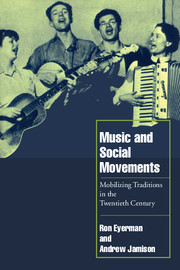Book contents
- Frontmatter
- Contents
- Acknowledgments
- Introduction
- 1 On social movements and culture
- 2 Taking traditions seriously
- 3 Making an alternative popular culture: from populism to the popular front
- 4 The movements of black music: from the New Negro to civil rights
- 5 Politics and music in the 1960s
- 6 From the sixties to the nineties: the case of Sweden
- 7 Structures of feeling and cognitive praxis
- Notes
- Bibliography
- Index
7 - Structures of feeling and cognitive praxis
Published online by Cambridge University Press: 26 October 2011
- Frontmatter
- Contents
- Acknowledgments
- Introduction
- 1 On social movements and culture
- 2 Taking traditions seriously
- 3 Making an alternative popular culture: from populism to the popular front
- 4 The movements of black music: from the New Negro to civil rights
- 5 Politics and music in the 1960s
- 6 From the sixties to the nineties: the case of Sweden
- 7 Structures of feeling and cognitive praxis
- Notes
- Bibliography
- Index
Summary
Structures of feeling and cultural transformation
We have discussed social movements in this book as articulators and transformers of culture. As forms of collective action emerging in social and historical contexts, social movements presuppose and make use of preexisting forms of social solidarity and communication: culture, that is, at its most basic. In the process, they draw upon and revitalize traditions at the same time as they transform them. As cultural as well as political actors, social movements reinterpret established and shared frameworks of meaning which make communication and coordinated action possible. This “common culture” comprises many levels and dimensions and takes on many specific forms, which can be broadly specified as national, regional, religious, class- and age-related, ethnic, and ideological. In this book, we have sought to show how common cultures change through the catalytic intervention of social movements.
Social movements also open spaces in which particular movement cultures – rituals, traditions, forms of artistic expression – can emerge. While such cultures are related to and dependent upon the deeper social structures from which they emerge, they are also capable of producing something new and different. Social movements produce innovative forms of understanding – what we have called exemplary action – which impact upon and are capable of transforming wider, established cultures.
- Type
- Chapter
- Information
- Music and Social MovementsMobilizing Traditions in the Twentieth Century, pp. 160 - 173Publisher: Cambridge University PressPrint publication year: 1998

